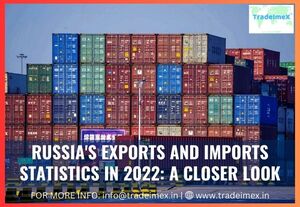-
 Retrouver dansMembres
Retrouver dansMembres Retrouver dansVidéos
Retrouver dansVidéos Retrouver dansChaînes
Retrouver dansChaînes
This website uses cookies to ensure you get the best experience on our website.
To learn more about our privacy policy Cliquez iciPréférence de confidentialité
-
- Dernière mise à jour 18 juillet 2023 0 commentaire , 195 vues, 0 comme
- New York, NY, USA - Obtenir des directions
More from Tradeimex Solution
More in Politics
Related Blogs
Russia Imports and Exports statistics
Posté par Tradeimex Solution
18 juillet 2023
Corps
Here are some key statistics on Russia Imports Data and exports Data:
Imports:
- In 2020, Russia's total imports amounted to approximately $222 billion USD.
- The country's main imported goods include machinery, vehicles, pharmaceuticals, plastics, electrical equipment, and various consumer goods.
- Key trading partners for Russia's imports include China, Germany, Belarus, the United States, and Italy.
Exports:
- In 2020, Russia's total exports were around $335 billion USD.
- The country's primary exports are oil, natural gas, metals (such as steel and aluminum), chemicals, and weapons.
- Russia's major export destinations include China, Germany, the Netherlands, Italy, and Turkey.
Trade Surplus:
- Russia has typically maintained a trade surplus due to its significant export revenues from oil and natural gas. However, the surplus can vary depending on global commodity prices and market conditions.
It's important to note that these statistics are based on data available up until 2020, and trade patterns can change over time. For the most up-to-date and comprehensive information, it is recommended to refer to official reports from relevant government agencies or international organizations that track trade data.
Photos
Carte
-
Emplacements sur MyWorldGo
Information de Lieu
- Emplacement: New York, NY, USA - Obtenir des directions
- Adresse formatée: New York, NY, USA
- Adresse de rue: New York
- Etat: New York
- Pays: United States










commentaires